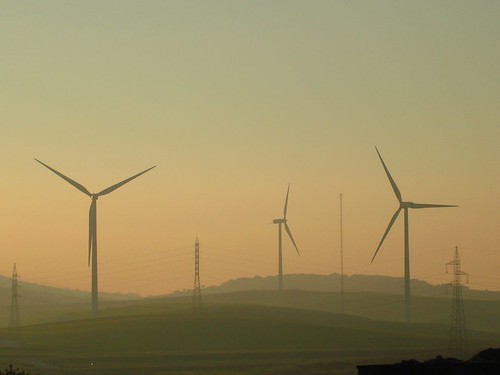Wind like Spain? It's a no-brainer
Posted by Big Gav in australia, spain, wind power
The Climate Spectator has an article from Matthew Wright urging Australia to follow Spain's example in the adoption of wind power - Wind like Spain? It's a no-brainer.
Wind power has the support of the majority of Australians, so it's painful to hear a small minority, most of them backed by fossil fuel interests, undermining one of the great universally available energy sources to power the world out to 2100. It is telling that the technology has very few detractors in those countries that aren't big net fossil fuel exporters.
As of this year, Spain has 20,000 wind turbines. If these were transplanted to Australia they would easily power our biggest state. That’s because wind turbines in Australia produce twice as much electricity as those installed in Spain, due to our superior resource.
With over 21,000MW capacity installed, Spain is 18 per cent wind powered and, with annual electricity demand the same as Australia's, is doubling their wind capacity by 2020. It's still full steam ahead on Spain's renewables program, despite a housing boom/bust that has sent their economy into a tailspin and caused over a million construction workers to lose their jobs.
Spain enjoys lower wholesale energy prices thanks to wind power, due to the merit order effect. Wind power significantly drives down electricity prices – and Australians, in 2011, are still missing out on the benefits of the price-lowering effect that large-scale wind deployments can deliver.
Using a fleet of modern Enercon E-125 or Siemens 6MW wind turbines, for the same installed capacity we would generate twice the amount of annual electricity generated, and we'd get twice the annual contribution of wind to our electricity mix. In other words we'd be on 35 per cent renewable electricity today.
It's a no brainer; to achieve the same amount of electricity as Spain from wind would come at a 75 per cent discount to what the Spanish have invested. That's because of the combination of "buy one get one free" – our wind resource generates twice as much as theirs and we're starting in 2011, 15-20 years after the Danes, Spanish and Germans who have done the heavy lifting and got the technology down the cost curve. Add to that the bonus that comes from the much cheaper turbines coming out of China exerting downward pressure on European turbine prices and you have a very cheap, well tested renewable resource. Time to get on with the job.
I’d hate to call it bludging, but we are also benefiting from the heavy lifting of countries like Denmark, Germany and Spain through their deployment programs to date. These European leaders have really got wind turbines (along with other renewable technologies) down the cost curve through the optimum combination of deployment – learning through doing and public and private research and development.
Many of Spain's turbines are older models. The new ones are more efficient, taking up as much as a third less space on the ground than much of the fleet in Spain, leaving more area for existing uses such as cropping. Australia, with 15 times the land area, and a huge choice on wind resource, could achieve 50 per cent wind with as few as 7,000 modern turbines. Or, with the same installed capacity as Spain, we would be getting 40 per cent of our electricity from wind and at a 75 per cent discount.
The potential for Australian wind doesn't stop there. Spain is on target to double their wind capacity to 35 per cent by 2020. With a practical near-term target like that we know that Australia could easily be getting 50 per cent of our energy from wind in a similar timeframe, with our combination of favourable conditions, less turbines, better sites, twice the output, half the cost, much bigger land area, better opportunities geographical distribution leading to better meteorological diversity, as well as much lower density of population and easier to access sites.
But Spain will actually have enough wind turbines to produce 70 per cent of our electricity by 2020. So what would happen if we installed that much capacity of wind here? Studies have already been done that give us an idea: they show that in the UK and Denmark, with 40 per cent penetration, 4 per cent of wind is actively curtailed and at 50 per cent, 7 per cent is to be curtailed.
That is, if we install wind turbines across the grid with an annual capacity factor so they are able, theoretically, to deliver 54 per cent of our electricity, due to a number of hours of oversupply and some transmission constraints, 7 per cent active curtailment would mean that 50 per cent of our energy would actually come from wind.






